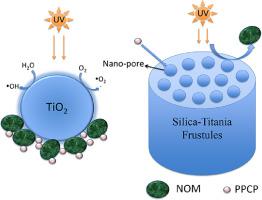Water Research ( IF 11.4 ) Pub Date : 2020-11-09 , DOI: 10.1016/j.watres.2020.116628 Yan Li , Chiqian Zhang , Zhiqiang Hu

|
Natural organic matter (NOM), such as humic acids, fulvic acids, and tannic acids, is ubiquitous in water bodies and hinders the photodegradation of pharmaceuticals and personal care products (PPCPs). We prepared titanium incorporated hierarchical diatoms as a novel photocatalyst to selectively remove PPCPs (triclosan, bisphenol A or BPA, and N, N-Diethyl-meta-toluamide or DEET) in the presence of NOM (humic acid). Diatom (Stephanodiscus hantzschii) grown in a titanium(IV) bis(ammonium lactato) dihydroxide solution integrated 7.2% ± 1.4% (mass fraction) of titanium in their cell wall and formed silica-titania frustules. The photodegradation of triclosan, BPA, and DEET by both silica-titania frustules and titania nanopowder (a control photocatalyst) follows pseudo-first-order kinetics. Under ultraviolent light irradiation, the titanium-content-normalized pseudo-first-order removal rate constants of triclosan, BPA, and DEET by silica-titania frustules were 3, 4, and 4-times those by titania nanopowder, respectively, at a humic acid concentration of 10 mg•L−1. Incorporation of titanium did not alter the morphology and hierarchical nano/microstructures of the diatom. The silica-titania frustules were rich in nanopores with a diameter of 20 ± 4 nm (mean ± standard deviation), allowing PPCPs with a small molecular weight (typically < 600 g•mol−1) to pass through while efficiently rejecting NOM with high molecular weights. The silica-titania frustules with hierarchical nano/microstructures served as a prefiltration unit by selectively allowing PPCPs to pass through the nanopores and are therefore promising for photodegradation and environmental remediation applications.
中文翻译:

在天然有机物存在下,通过钛结合的分层硅藻选择性地从水中去除药品和个人护理产品
腐殖酸,黄腐酸和单宁酸等天然有机物(NOM)在水体中无处不在,并阻碍了药物和个人护理产品(PPCP)的光降解。我们制备了掺钛的分层硅藻作为新型光催化剂,可在NOM(腐殖酸)存在下选择性去除PPCP(三氯生,双酚A或BPA以及N,N-二乙基-间甲酰胺或DEET)。硅藻(Stephanodiscus hantzschii)在钛(IV)双(乳酸铵)氢氧化物溶液中生长,在其细胞壁中整合了7.2%±1.4%(质量分数)的钛,并形成了二氧化硅-二氧化钛壳。二氧化硅-二氧化钛壳层和二氧化钛纳米粉(一种对照光催化剂)对三氯生,BPA和DEET的光降解遵循拟一级动力学。在紫外光照射下,在腐殖酸溶液中三氧化钛,双酚A和DEET的钛含量归一化的假一阶去除速率常数分别为三氧化钛纳米粉的三倍,四倍和四倍。酸浓度为10 mg•L -1。钛的掺入没有改变硅藻的形态和分级的纳米/微观结构。二氧化硅-二氧化钛壳中富含纳米孔,直径为20±4 nm(均值±标准偏差),使分子量小的(通常<600 g•mol -1)的PPCP通过,同时有效地拒绝了高分子量的NOM。分子量。具有层次结构的纳米/微结构的二氧化硅-二氧化钛壳层通过选择性地允许PPCP通过纳米孔而用作预过滤单元,因此有望用于光降解和环境修复应用。











































 京公网安备 11010802027423号
京公网安备 11010802027423号